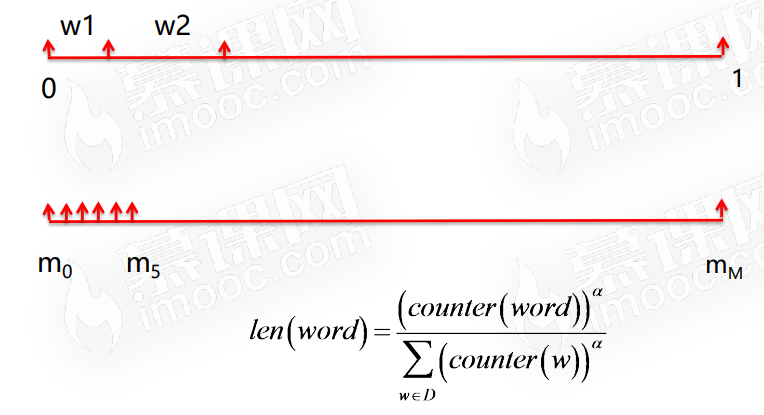个性化召回算法Item2Vec原理及自编程实现。
算法原理
计算items之间的相似性是现代推荐系统中的一个关键组成部分。过去,人们只是通过判断“有无”的方式来向量化系统中的各个items,这样的方式并不能很好地表示出items之间的关系,而且泛化能力很差。因此需要一种特殊的方法来将items映射到能够满足我们需求的向量上去。
后来研究人员研究出了使用SVD(奇异值分解,矩阵分解的一种)的方式来计算表示items的向量,这种方法从某种程度上已经满足了人们在计算items的相似性以及模型泛化能力的需求了。但是随着自然语言领域不断发展,研究人员开发出了一种叫做word2vec的神经语言模型,通过神经网络模型来隐式地计算出词汇表中的每一个单词的向量化表示,这种表示方式能够很好地描述单词间的语义和语法关系,从而使得模型具有相当的泛化能力,因此该方法及其变形已经被广泛地应用到NLP领域的各个方面。
因此可以使用相似的方法来计算协助过滤中所有items的向量化表示,从而隐式地得到items间的相互关系,使得我们能够更好地计算出items间的相似性以及提升模型的泛化能力。
背景
- Item2Item的推荐方式效果显著
- NN model的特征抽象能力
- 算法论文:ITEM2VEC: Neural Item Embedding For Collaborative Filtering
物理意义
- 将用户的行为序列转化为item组成的句子
- 模仿word2vec训练word embedding将item embedding
缺陷
- 用户的行为序列时序性缺失
- 用户行为序列中的item强度是无区分性的
Item2Vec算法应用主流程
- 从log中抽取用户行为序列(day级别等)
- 将行为序列当成语料训练word2vec得到item embedding
- 得到item sim关系用于推荐
Item2Vec算法依赖模型word2vec
CBOW (continuous bag of words)
待补
Skip-gram模型
待补
负采样算法
由于词在预料中出现的次数有高有低,对于高频词,被选为负样本的概率应该就比较高,因此本质上就是一个带权采样问题。

算法实现
1
2
3
4
5
6
7
8
9
10
11
12
13
14
15
16
17
18
19
20
21
22
23
24
25
26
27
28
29
| def produce_train_data(input_file, out_file):
"""
:param input_file: user behavior file
:param out_file: output file
"""
if not os.path.exists(input_file):
return
record = {}
score_thr = 4
linenum = 0
fp = open(input_file)
for line in fp:
if linenum == 0:
linenum += 1
continue
item = line.strip().split(',')
if len(item) < 4:
continue
userid, itemid, rating = item[0], item[1], float(item[2])
if rating < score_thr:
continue
if userid not in record:
record[userid] = []
record[userid].append(itemid)
fp.close()
fw = open(out_file, "w+")
for userid in record:
fw.write(" ".join(record[userid]) + "\n")
fw.close()
|
- 将item序列喂给word2vec模型,得到item的embedding文件
- gensim 或 word2vec c版本
1
2
3
| sentences = word2vec.LineSentence("../data/train_data.txt")
model = word2vec.Word2Vec(sentences, sg=1, vector_size=128, window=5, sample=1e-3, hs=0, negative=5, epochs=100)
model.wv.save_word2vec_format("../data/item_vec.txt", binary=False)
|
1
2
3
4
5
6
7
8
9
10
11
12
13
14
15
16
17
18
19
20
21
22
23
24
25
26
27
28
29
30
31
32
33
34
35
36
37
38
39
40
41
42
43
44
45
46
47
48
49
50
51
52
53
54
| def load_item_vec(input_file):
"""
:param input_file: item vec file
:return: dict key:itemid value:np.array([num1,num2...])
"""
if not os.path.exists(input_file):
return {}
linenum = 0
item_vec = {}
fp = open(input_file)
for line in fp:
if linenum == 0:
linenum += 1
continue
item = line.strip().split()
if len(item) < 129:
continue
itemid = item[0]
if itemid == "</s>":
continue
item_vec[itemid] = np.array([float(ele) for ele in item[1:]])
fp.close()
return item_vec
def cal_item_sim(item_vec, itemid, output_file):
"""
:param item_vec: item embedding vector
:param itemid: fixed itemid to clac item sim
:param output_file: the file to store result
"""
if itemid not in item_vec:
return
score = {}
topk = 10
fix_item_vec = item_vec[itemid]
for tmp_itemid in item_vec:
if tmp_itemid == itemid:
continue
tmp_itemvec = item_vec[tmp_itemid]
fenmu = np.linalg.norm(fix_item_vec) * np.linalg.norm(tmp_itemvec)
if fenmu == 0:
score[tmp_itemid] = 0
else:
score[tmp_itemid] = round(np.dot(fix_item_vec, tmp_itemvec) / fenmu, 3)
fw = open(output_file, "w+")
out_str = itemid + "\t"
tmp_list = []
for co in sorted(score.items(), key=operator.itemgetter(1), reverse=True)[:topk]:
tmp_list.append(co[0] + "_" + str(co[1]))
out_str += ";".join(tmp_list)
fw.write(out_str + "\n")
fw.close()
|
- 编写shell脚本串联过程,使用spark等进行并行计算
